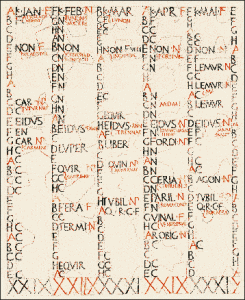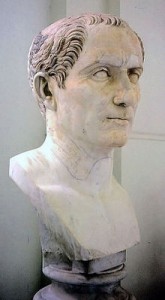First and foremost, hello everyone and Happy Leap Year!

Julius Caesar was behind the origin of leap year in 45 BC. The early Romans had a 355 day calendar and to keep festivals occurring around the same season each year- a 22 or 23 day month was created every second year.

TALK ABOUT CONFUSING!
The calendar was regulated by the movement of the moon, and this had made it a bit of mess and confusing. Caesar replaced this calendar with the Egyptian calendar, which was regulated by the sun. He set the length of the year to 365.25 days by adding an intercalary/leap day at the end of February every fourth year.

Bust of Julius Caesar. Courtesy of WikiCommons.
Furthermore, in order to bring the calendar into alignment with the seasons, he decreed that three extra months be inserted into 46 BC (the ordinary intercalary month at the end of February, and two extra months after November).
For a post more about the calendar, check it out here and here!
This is known as the Julian Calendar which started on on 1 January 45 BC. Also, this calendar is almost identical to the current Western calendar.
| Months (Latin) |
Lengths before 45 BC |
Lengths as of 45 BC |
Months (English) |
| Ianuarius |
29 |
31 |
January |
| Februarius |
28 (in common years)
In intercalary years:
23 if Intercalaris is variable
23/24 if Intercalaris is fixed |
28 (leap years: 29) |
February |
| Mercedonius/Intercalaris |
0 (leap years: variable (27/28 days)
or fixed) |
(abolished) |
— |
| Martius |
31 |
31 |
March |
| Aprilis |
29 |
30 |
April |
| Maius |
31 |
31 |
May |
| Iunius |
29 |
30 |
June |
| Quintilis(Iulius) |
31 |
31 |
July |
| Sextilis (Augustus) |
29 |
31 |
August |
| September |
29 |
30 |
September |
| October |
31 |
31 |
October |
| November |
29 |
30 |
November |
| December |
29 |
31 |
December |
I should note that the actual calculation for the calendar were made by Caesar’s astronomer, Sosigenes.

Pope Gregory XIII
In 1582, Pope Gregory XIII further refined the calendar with the rule that leap day would occur in any year divisible by 4.
So there you have it a condensed and concise overview of the leap year! Well I hope you enjoyed








